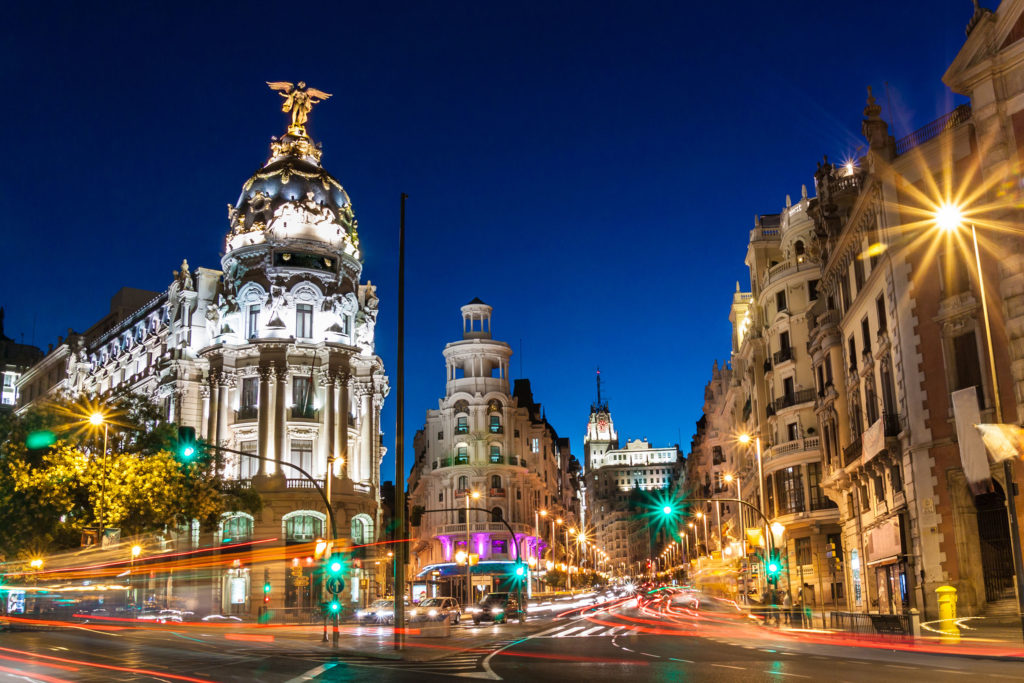Perched on a rocky plateau 667m above sea level, Madrid rose to prominence in 1561 when King Felipe II made the small market town his capital. It was, he said, ‘a city fulfilling the functions of a heart located in the middle of the body’. Besides a brief spell in the 17th century, when Valladolid was top dog, Madrid has been Spain’s chief city ever since, growing steadily to become a metropolis known for its eclectic architecture and fine food.
Get your bearings
At the very centre is Puerta del Sol (the Gate of the Sun) where the old east-facing gates once stood. Nearby – slicing through the city diagonally – is Gran Vía, a busy road lined with ornate buildings: a mix of Baroque towers and flourishing Art Deco style.
Check in The ME by Meliá on Plaza de Santa Ana has 192 slick rooms housed in a 19th-century palace. All guests have access to the popular rooftop bar, while those who upgrade to a suite are given their own ‘personal assistant’.
Overlooking the grand Buen Retiro Park, the Hotel Hospes on Plaza de la Independencia boasts 41 comfortable rooms (think soothing taupe interiors with a splash of fuchsia) and offers free bike rental. Art and design feature heavily at the Hotel Artrip on Calle Valencia. Beyond the 17 minimalist white-themed rooms are small exhibitions showcasing up-and- coming artists.
Take a hike
Start at the Royal Palace of Madrid on Calle Bailén, the seat of Spanish royalty since the 1760s. The palace is now used primarily for ceremonial events and a handful of its more than 3 000 rooms are open to the public.
After visiting the palace, walk south and turn left on to Calle Mayor. About halfway along, on the right, is Plaza de la Villa with Medieval buildings, including the former town hall and jail. Continue and veer right through the northern archways of Plaza Mayor. The square is dominated by the Casa de la Panadería (Royal Bakery), its colourful facade decorated with frescos of zodiac signs by artist Carlos Franco. It was once the site of gruesome executions during the Inquisition and bullfights, but these days it’s filled with buskers and cafes.
Lunch on the run Dating back to 1916, the renovated Mercado de San Miguel on Plaza de San Miguel has been transformed into a tapas hall with a cast-iron exterior and floor-to-ceiling windows. Inside are dozens of stands with everything from oysters and salty Ibérico ham to plump croquettes and stuffed olives. Load up your plate, then grab a drink – try the sangria.
Swipe your card
There’s good retail therapy to be had in the neighbourhoods of Chueca and Malasaña to the north. Meander down Calle del Piamonte for stylish boutiques, and wander the pedestrianised Calle de Fuencarral and nearby Calle Colón for independent stores.
Eat like a local
The best place to try the hearty traditional callos a la Madrileña (stewed tripe) is at bustling La Bola on Calle Bola. You may spot former king Juan Carlos at the next table. For the best tapas in the city, head over to Calle Cava Baja: a narrow strip in La Latina lined with cramped but cosy spots such as Taberna de Conspiradores. Ask for the tiny, private dining room at the back – about the size of a cupboard – and order the paprika-dusted patatas bravas and chorizo in wine and honey.
Row your boat
Until 1767, Buen Retiro Park on Plaza de la Independencia was for the exclusive use of royalty, and its sprawling lawns, large lake and sculpted cypresses were often the backdrop for lavish theatrical productions. These days, it’s open to all. Rent a rowing boat from beside the King Alfonso XII monument or wander down to the domed Palacio de Cristal, erected in 1887 as a greenhouse.
Get arty
The best museums are within walking distance of one another. Start off at the Museo Nacional Centro de Arte Reina Sofía at Calle Santa Isabel, to get a look at Picasso’s Guernica, then stroll north to the Museo del Prado. Its four floors house works spanning more than seven centuries by greats such as Caravaggio and Raphael. Finish at the Museo Thyssen-Bornemisza on Paseo del Prado, famed for its varied collection of Renaissance, abstract surrealist and pop art pieces.
Hit the market
The open-air El Rastro flea market takes over Plaza de Cascorro and surrounding streets every Sunday from 9 am to 3 pm. Considered to be one of the largest of its kind in Europe with an estimated 3 500 stalls, it’s the place to go for antiques, art and all stops in between. Remember to top up on souvenirs and gifts for your friends and family back home while you’re at it!
For travel arrangements to Madrid, contact Diners Club Concierge Service on 0861 DINERS (346377), complimentary for those who BELONG
Text: Nick Boulos/The Interview People; PHOTOGRAPHY: gallo/gettyimages, istockphoto

